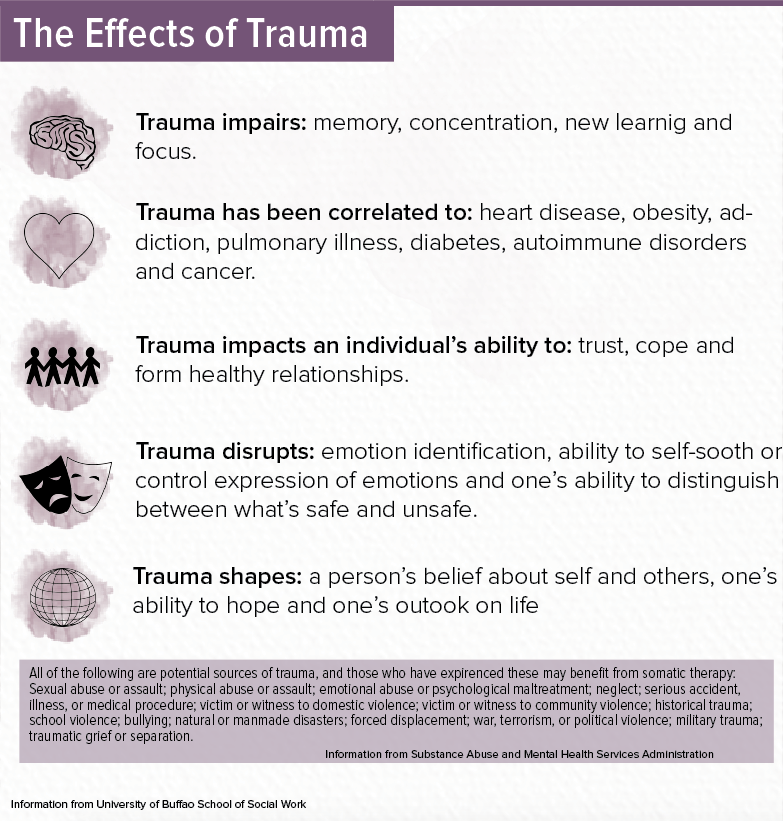A SPLATTERED MIND
Somatic therapy is becoming a viable option for teens expirencing trauma and anxiety
For high school students searching for coping mechanisms, there are better ways of treating forms of trauma than alcohol and drug use as a form of “self-medication,” in which the substance makes the individual feel better able to deal with life. Current therapies are now helping teens successfully deal with anxiety and traumatized nervous systems without medications and traditional therapy.
Being abused by a family member as a child, feeling helpless and powerless, experiencing a brush with death — these are all potential sources of trauma, which is the number one cause of death in Americans aged 1-46, according to the National Trauma Institute.
Dr. Robert Coffman is a psychotherapist, based in Beverly Hills, who specializes in somatic therapy — a form of therapy that focuses on the ways the body is connected to the mind, according to the United States Association for Body Psychotherapy. His patients include people who have trauma or PTSD, have been in car accidents, have eating disorders or are experiencing grief or loss.
If victims cannot fight or flee from something “dangerous” or “overwhelming” they go into a third response, known as “freeze,” according to Dr. Coffman.
“When you go into freeze, your nervous system goes into somewhat of a conservation mode, and you become disconnected, and the pain of the trauma doesn’t register in your body because your body actually excretes natural opioids,” Coffman said.
Daniel Ziegler, class of 2015, has a phobia of needles that he believes originated from a childhood kidney operation.
“Whenever there was anything brought up of [needles], I would definitely be thrown off and I had to fight my way out of passing out,” Ziegler said. “Whenever it happens my hands are like freezing cold; you start to kind of lose control — it’s just very uncomfortable.”
Dr. Robin Roberts, a Westwood-based psychotherapist, is a frequent lecturer and field instructor in various health fields at UCLA, her alma mater. Similar to Dr. Coffman, Roberts’ work focuses on a “union and balance of the elements of mind, body and spirit,” according to her website.
“It’s a myth that mental illness is in your head; it’s not true. Mental illness is no different than any physical illness, and most of what we call ‘symptoms’ of mental illness are actually physical,” Roberts said. “Just as talking alone isn’t going to cure your diabetes, talking alone can’t cure depression, either.”
While Ziegler can still watch a gory movie without being affected by his phobia, his fear is triggered in specific situations involved needles and syringes, such as giving blood.
“I had to fight my way out of passing out. Whenever it happens my hands are freezing cold; you start to kind of lose control — it’s just very uncomfortable.”
–Daniel Ziegler on eperiencing trauma symptoms
Ziegler finds talking about his phobia of needles “difficult,” and did not begin attending therapy until he was a senior in high school.
During the therapy sessions, Ziegler and Dr. Debra Clydesdale, a somatic therapist, would discuss things to try to “trigger some type of reaction.” Whenever there was a reaction, no matter how small, Dr. Clydesdale would have Ziegler focus on it, relax and try to “let [the reaction] pass through.”
“[Dr. Clydesdale] would tell me to think about a place where I felt very comfortable, and then once I stopped feeling uncomfortable and started to settle down, I would start to shake — uncontrollably sometimes,” Ziegler said. “From there, we used breathing techniques. Then after that you feel kind of like a zombie, just super relaxed.”
Ziegler enjoyed the slow, “small steps” he made towards progress in therapy, especially since his therapist knew not to “push [him] farther than [he] could go.”

Ziegler believes that the main point of therapy is for patients to “learn how to deal” with the trauma and triggers on their own. He uses the breathing techniques he learned in therapy whenever he needs to “get centered.”
In therapy sessions, Coffman pays particular attention to the breathing of a patient: he has patients with shallow breathing stretch their muscles by leaning against walls and bending their knees or laying over medicine balls to stretch their “tight” back muscles. Through these exercises, Coffman intends to increase the energy charge in their bodies by expanding their breathing and metabolism, which he believes helps his patients “have their emotions push through.”
“It’s a myth that mental illness is in your head; it’s not true. Mental illness is no different than any physical illness, and most of what we call ‘symptoms’ of mental illness are actually physical.”
-Dr. Robin Roberts
Reactions to trauma can be triggered by simulating situations. In Coffman’s practice, he has patients stand up, and asks them about how they feel in their chest when they simulate standing in a specific situation — such as in front of their father — then he will “sculpt” their body in the exact opposite way that they stand.
Different postures can lead to different emotions — humiliation and disapproval when standing in front of their father with a concave-chest, or pride and approval when standing in front of their father with their chests out — and Coffman utilizes them to access the psychology of his patients.
“I see things in their body that you know are connected to psychological issues. I get them, in their own language, to try to identify with those things,” Coffman said.
Additionally, Coffman will have patients perform relaxation exercises and “gradual body awareness” exercises, having them go “very slowly” while paying attention to their bodies’ activities.
“When people notice their body reactions, they often notice that the patterns occur over and over,” Coffman said. “I want them to begin to associate that when they think of someone or something, they have these feelings, these sensations and these kinds of activities in their body.”
In light of the school shooting at Stoneman Douglas High School in Parkland, Florida on Feb. 14, 2018, Coffman believes that the survivors of shooting incidents will have PTSD, and that, as with other trauma victims, they will “need to get professional help as soon as possible.”
“They’ll have an exaggerated response to anything visually, auditorily, tactilely — anything that has a reference to the incident. They may hear a car backfire and they may start shaking or having a panic attack,” Coffman said.
Stress from the “freeze” response doesn’t necessarily need a real trigger, either. Roberts referenced the recent Parkland shooting, saying that just the thought of a traumatic event can cause a buildup of stress and adrenaline that needs to be released.
“It was terrifying in your imagination, when nothing was happening around you, but your nervous system still activated. In the end that’s a secondary trauma, meaning you heard about it, you didn’t directly experience it, but your nervous system still reacted,” Roberts said.
Ziegler did therapy for about a year. While he says that he since been “triggered back,” he believes that the therapy was “super effective.”
“At the time after therapy, I stuck an acupuncture needle in my arm and I dealt with that and I was fine. I don’t know if I can do that now,” Ziegler said. “I don’t think I ever got to the point where [my phobia] was totally fleshed out — I just got to a point where it would be really manageable.”
“I see things in their body that you know are connected to psychological issues. I get them, in their own language, to try to identify with those things.”
-Dr. Robert Coffman
Coffman’s sessions usually last an hour, and his patients typically visit his office once a week. The duration of therapy can last as short as two to three months; people who do “light recovery” see Coffman for six to nine months, while long-term patients — sometimes making up two-thirds of his patients — attend sessions for two to five years.
Coffman suggests that trauma victims seek a therapist who does both talk and body therapy; he also suggests that people with trauma get professional help as soon as possible.
“The longer you leave the shock in your body, the worse it gets,” Coffman said.
For people considering somatic therapy, Roberts believes that the process would not only help them “get to the source of the problem” but likely also leave them “feeling better in their own skin.”
“They should expect to not be passive, but to be involved in their own care; they should be ready to learn a lot about themselves,” Roberts said. “I think people should expect to be surprised that the conscious mind doesn’t know everything, and that when given support, our body knows how to heal itself.”
Coffman has had his clients’ spouses and significant others tell him how “unrecognizable” the patient is after therapy, like “a completely new person.” But to Coffman, patients must be dedicated, themselves, to recovering in order for the therapy to be successful.
“People that are very motivated get a lot more out of therapy than people who are less motivated. People who work hard and understand what I’m doing or try to get more out of therapy,” Coffman said. “They realize that changing their personality in a deep way takes a deep commitment.”




